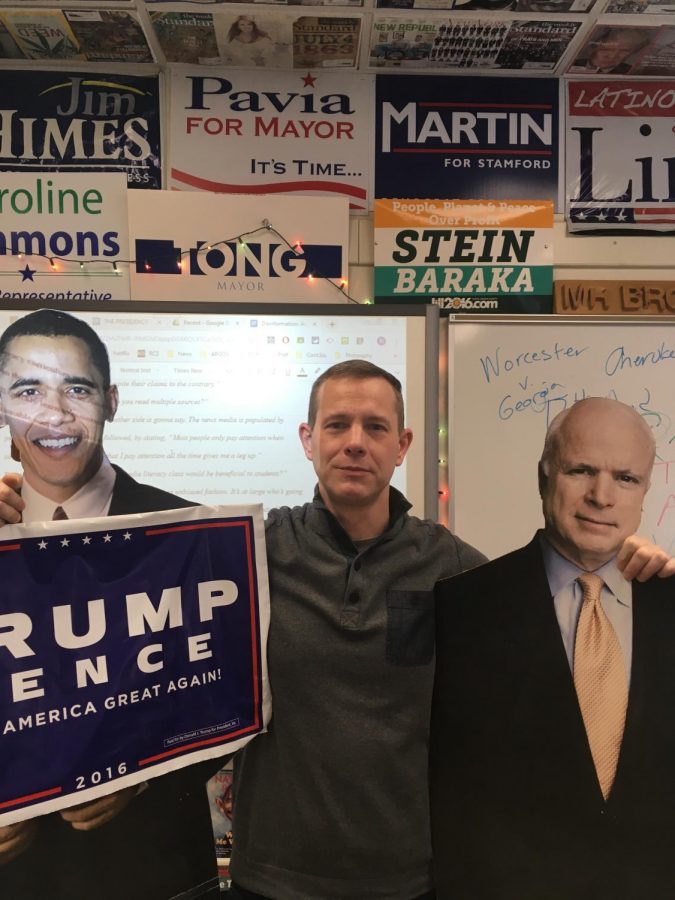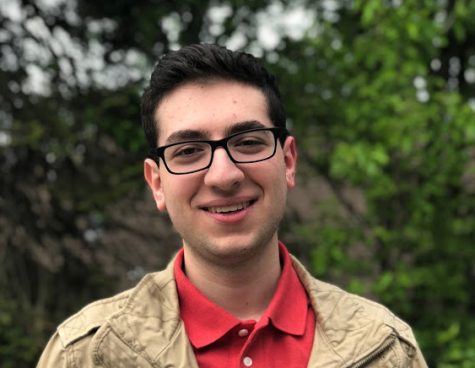Disinformation And What Teens Can Do to Fight It
Why Stamford High Should Institute a Media Literacy Class
History teacher Michael Brown gives his opinion on disinformation on the internet.
January 4, 2019
Most teenagers in America are first exposed to the political and social climates of their country during their time in high school. Whether it be in U.S. History or a political afterschool club, it is practically impossible for teens to go through their high school experience without having to question where their political opinions will align. This has become increasingly true in recent years as American politics continue to polarize, partially due to the growing threat of disinformation.
A study done by Pew Research in December of 2016 revealed that nearly nine out of 10 American adults admitted that fake news was affecting their current understanding of “basic facts and events.” This was especially true in the 2016 U.S. presidential election. As adults find themselves lost and frustrated in hurdles of disinformation—whether it be undisclosed bias in news articles or blatant conspiracy theories circling the internet—it is due time that the next generation step in, including the students of Stamford High.
In the 21st century, having skills in media literacy has become a necessity. As the internet continues to expand around the globe, so too does the amount of misleading information circling websites. According to Freedom House, a nonpartisan organization that actively works to defend and protect rights and civil liberties, the freedom of the internet in the United States has been on the decline since 2012. The flooding of false information on social media websites is able to reach the general public much faster than accurate news articles published by credible journalists, propagating confusion. In addition, Russian trolls have been caught spreading disinformation on websites such as Facebook, attempting to further polarize the political climate. Many high school students, who are just beginning to experience the political environment of America, are unaware of the widespread pervasiveness of disinformation. In order to form a proper political opinion based on true and accurate facts, students should be exposed to the true environment of social and digital media through what some call media literacy.
A recent movement has emerged in several states across the nation to incorporate media literacy programs into school curriculums. At the forefront of this movement lies an organization called Media Literacy Now, who call themselves the “leading national advocacy organization for media literacy education policy.” The goal of Media Literacy Now is to empower, engage, and drive civic participation in young students by teaching them to identify disinformation on the internet. According to a study cited on the site, “Children ages 8 to 18 now spend an average of 7 hours and 38 minutes per day with entertainment media outside of school.” Students are more susceptible than ever to encounter disinformation that they could mistake as accurate fact, which could leave them with preconceived biases in politics that are entirely false. Thanks to the efforts of Media Literacy Now and other organizations involved in the fight against disinformation, media literacy curriculums in education are currently under “implementation” in the state of Connecticut; the sooner these curriculums arrive, the better it is for students.
Although it may seem unimportant to some teenagers, developing literacy in media during high school could give students a fundamental advantage in their future endeavors as young adults. Seniors are less than a year away from being eligible to vote and must start developing a coherent ability to process information that they find online. They need to be entering the world as informed citizens—not blind ones. The importance of media literacy continues to grow every year due to polarizing politics, and should be incorporated into a class curriculum at Stamford High.
Reading the news, understanding contemporary politics and voting are basic essentialities in our society and can be kept to a higher standard if people are educated to be more familiar with fact. By arming the next generation with skills to identify disinformation, false propaganda will have a much harder time spreading across the internet, mitigating its effects at the ballot polls.
Students should already understand that background knowledge and information is necessary to form and acquire legitimate opinions that they can express at voting polls every November. But the widespread pervasiveness of disinformation online can influence adults just as easily as students. However, we can learn from the adults that do maintain media literacy, such as history teacher Michael Brown. In a short interview with Brown, I discussed the following:
Dattolo: “Did you find the 2016 election hard to follow and to form opinions?”
Brown: “No.”
Dattolo: “How did you prevent being susceptible to disinformation?”
Brown: “First off, I stayed off social media. That’s not particularly practical for most people though. I tend to read information from a variety of sources. I can generally argue both sides of the issue. I didn’t become overly emotional about the campaign. I’ve been a firm believer that the media has never been unbiased despite their claims to the contrary.”
Dattolo: “If you believe that why do you read multiple sources?”
Brown: “I want to know what the other side is gonna say. The news media is populated by people. People have bias.” He followed, by stating, “Most people only pay attention when something is going on. The fact that I pay attention all the time gives me a leg up.”
Dattolo: “Do you think a mandatory media literacy class would be beneficial to students?”
Brown: “Yes. If the class is taught responsibly and an unbiased fashion. It depends on who’s going to teach the course… That person cannot use their own platform for influencing minds. If you have a class talking about the political landscape… there are forces outside these walls that are going to be very reactive to that. It’s recognizing that both sides are sanctimonious and self-righteous.”
Instating a mandatory media literacy curriculum in high schools would provide students with skills that have become essential in this day and age in America. By tackling disinformation at a young age, the next generation will quickly learn to maintain a healthy skepticism of information they see online from questionable sources. Moreover, students can recognize bias more easily within articles they may encounter online. It is essential to convey to teenagers that opinion should never be taken as absolute fact. Ultimately, it is in the hands of the generation that grew up with social media to combat the social and political issues it has caused, especially disinformation. At Stamford High, that could all start with a media literacy class.





